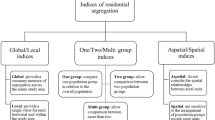Abstract
Survival data analysis occasionally encounters a situation that some unknown risk factors affect survival times. One way of considering these factors is the use of frailty models. In some applications, the survival data are spatially correlated. In this paper, a geostatistical spatial survival model is introduced to analyze the survival data where their locations are continuously patterned in a region. Regarding this concern, a simulation method is introduced to generate a set of spatial survival data. Then the efficiency of Cox proportional hazards, frailty and spatial survival models for fitting to spatial survival data are compared. Finally, these models are used to explore the pattern of infecting Cercosporiose in olive trees. Results show that the location of each olive tree can be effective on suffering from Cercosporiose.



Similar content being viewed by others
References
Banerjee S, Wall MM, Carlin BP (2003) Frailty modeling for spatially correlated survival data, with application to infant mortality in Minnesota. Biostatistics 4:123–142
Bender R, Augustin T, Blettner M (2005) Generating survival times to simulate Cox proportional hazards models. Stat Med 24:1713–1723
Clayton DG, Cuzik J (1985) Multivariate generalization of the proportional hazards model. J R Stat Soc A 148:82–117
Cox DR (1972) Regression models and life-tables. J R Stat Soc B 34:187–220
Diva U, Banerjee S, Dey DK (2007) Modeling spatially correlated survival data for individuals with multiple cancers. Stat Model 7:191–213
Ferrario PG (2016) Partitioning estimation of local variance based on nearest neighbors under censoring. Stat Pap. doi:10.1007/s00362-016-0770-y
Hanson T, Jara A, Zhao L (2012) A Bayesian semi-parametric temporally stratified proportional hazards model with spatial frailties. Bayesian Anal 7:147–188
Lerch M (1903) Sur un point de la thorie des fonctions gnratrices d’Abel. Acta Math 27:339–351
Li Y, Ryan L (2002) Modeling spatial survival data using semiparametric frailty models. Biometrics 58:287–297
Liebscher E, Schabe H (1997) A generalization of the Kaplan–Meier estimator to Harris-recurrent Markov chains. Stat Pap 38:63–75
Motarjem K, Mohammadzadeh M, Abyar A (2015) Frailty and proportional hazards models for analysis of spatial survival data. J Adv Math Model 4:101–117
R Core Team (2015) R: a language and environment for statistical computing. R Foundation for Statistical Computing, Vienna. http://www.R-project.org/
Sergeeva V, Spooner-Hart R (2009) Anthracnose and Cercosporiose on olives in Australia: an update. Aust N Z Olivegrowner Process 65:31–34
Taylor BM (2015) Auxiliary variable Markove chain Monte Carlo for spatial survival and geostatistical models. arXiv: 1501.01665v1
Vaupel JW, Manton KG, Stallard E (1979) The impact of heterogeneity in individual frailty on the dynamics of mortality. Demography 16:439–454
Wienke A (2011) Frailty models in survival analysis. Chapman & Hall, Boca Raton, pp 209–222
Yashin AI, Vaupel JW, Iachine I (1995) Correlated individual frailty: an advantageous approach to survival analysis of bivariate data. Math Popul Stud 5:1–15
Acknowledgements
The authors are thankful to the referees for their many helpful comments that greatly improved this paper. We also wish to acknowledge for the support from Center of Excellence of Spatial and Spatio-Temporal Data Analysis in Tarbiat Modares University.
Author information
Authors and Affiliations
Corresponding author
Rights and permissions
About this article
Cite this article
Motarjem, K., Mohammadzadeh, M. & Abyar, A. Geostatistical survival model with Gaussian random effect. Stat Papers 61, 85–107 (2020). https://doi.org/10.1007/s00362-017-0922-8
Received:
Revised:
Published:
Issue Date:
DOI: https://doi.org/10.1007/s00362-017-0922-8
Keywords
- Cox proportional hazards model
- Unknown risk factors
- Spatial random effect
- Geostatistical spatial survival model
- Cercosporiose




